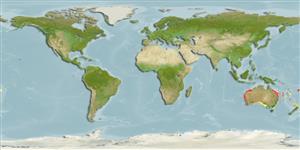Environment: milieu / climate zone / depth range / distribution range
Ökologie
seewasser demersal; tiefenbereich 30 - 345 m (Ref. 86254). Subtropical; 17°S - 39°S (Ref. 86254)
Indo-West Pacific: Eastern Australia.
Size / Gewicht / Alter
Maturity: Lm ? range ? - ? cm
Max length : 39.1 cm SL Männchen/unbestimmt; (Ref. 86254)
Rückenflossenstacheln (insgesamt) : 10; Rückenflossenweichstrahlen (insgesamt) : 10 - 11; Afterflossenstacheln: 0; Afterflossenweichstrahlen: 12. This species is distinguished by the following characters: 80-93 anteroventrally slanted oblique scale rows above lateral line; snout length 29.5-32.3% HL, slightly decreasing proportionally with growth; pectoral fin length 13.9-15.8% SL; pelvic fin length 22.1-28.5% SL; nasal bone with tubercles in larger specimens; dorsal surface of head with large, pale to dark-brown irregularly shaped spots, body without spots dorsally; pelvic fin with large brown spots (Ref. 86254).
Occurs over gravel bottom of the continental shelf and continental slope (Ref. 75154).
Life cycle and mating behavior
Geschlechtsreife | Fortpflanzung | Ablaichen | Eier | Fecundity | Larven
Imamura, H. and M.F. Gomon, 2010. Taxonomic revision of the genus Ratabulus (Teleostei: Platycephalidae), with descriptions of two new species from Australia. Memoirs of Museum Victoria 67:19-33. (Ref. 86254)
IUCN Rote Liste Status (Ref. 130435: Version 2024-2)
Bedrohung für Menschen
Harmless
Nutzung durch Menschen
Tools
Zusatzinformationen
Download XML
Internet Quellen
Estimates based on models
Preferred temperature (Ref.
123201): 14.3 - 24.5, mean 19.7 °C (based on 83 cells).
Phylogenetic diversity index (Ref.
82804): PD
50 = 0.5625 [Uniqueness, from 0.5 = low to 2.0 = high].
Bayesian length-weight: a=0.00457 (0.00230 - 0.00908), b=3.09 (2.91 - 3.27), in cm total length, based on LWR estimates for this (Sub)family-body shape (Ref.
93245).
Trophic level (Ref.
69278): 3.9 ±0.7 se; based on size and trophs of closest relatives
Widerstandsfähigkeit (Ref.
120179): mittel, Verdopplung der Population dauert 1,4 - 4,4 Jahre. (Preliminary K or Fecundity.).
Fishing Vulnerability (Ref.
59153): Moderate vulnerability (38 of 100).
